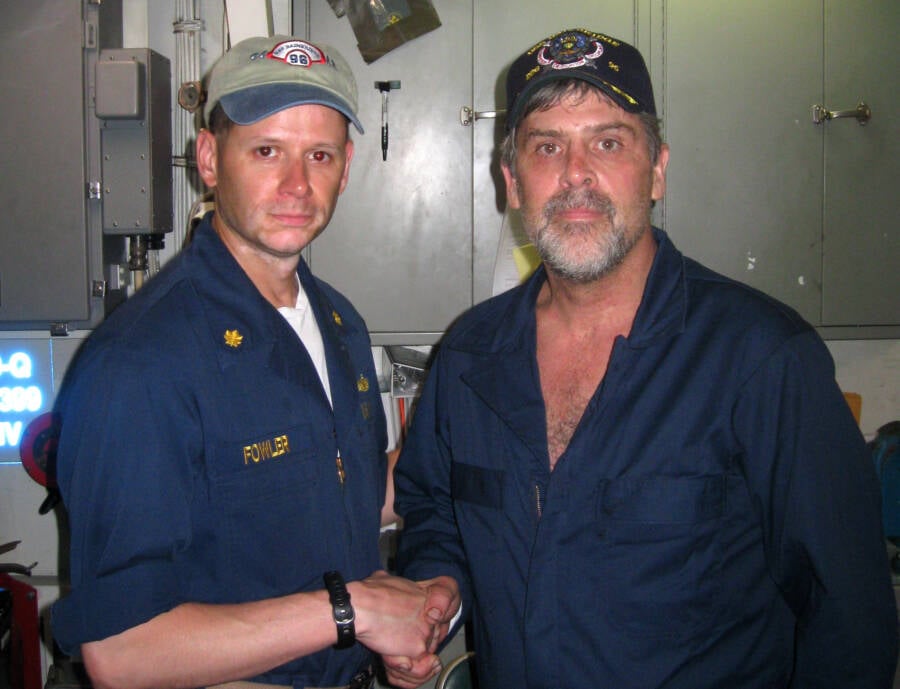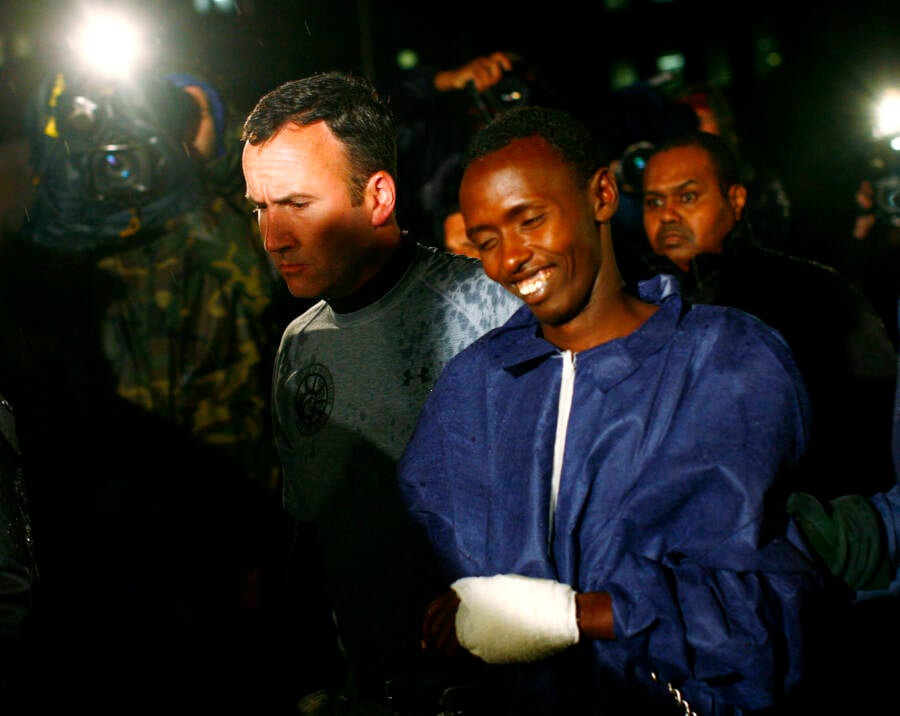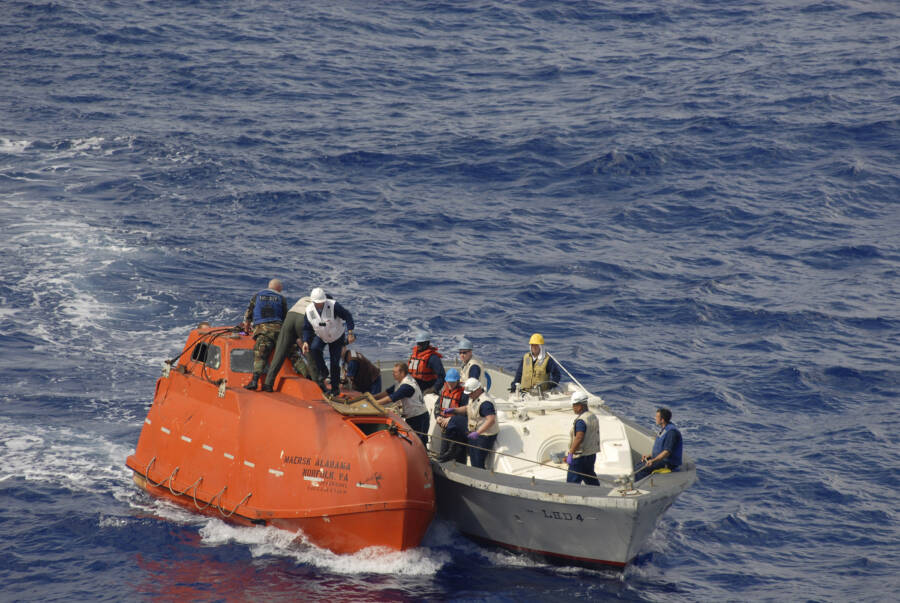In a harrowing ordeal that later inspired the film Captain Phillips, four Somali pirates hijacked the MV Maersk Alabama and kidnapped Captain Richard Phillips in April 2009.

Darren McCollester/Getty ImagesRichard Phillips greeting his family after being rescued from Somali pirates by U.S. Navy SEALs.
On Oct. 11, 2013, the Tom Hanks-led film Captain Phillips released to critical acclaim. It told the story of Captain Richard Phillips, whose ship, the MV Maersk Alabama, was taken captive by a group of Somali pirates before Phillips himself was held hostage on an enclosed lifeboat.
The film’s promotional materials stated that it was based on a true story, and indeed, there really was a Captain Phillips who was kidnapped by a group of Somali pirates. But as with any Hollywood adaptation, certain liberties were taken with the story — and with the character of Richard Phillips.
The film was largely based on Phillips’ own account of the situation, as told in his book A Captain’s Duty, which has come under scrutiny in the years since for not painting a wholly accurate picture.
So what really happened?
The MV Maersk Alabama Hijacking
In early April, 2009, a container ship operated by the Virginia-based Maersk Line was traveling from Salālah, Oman to Mombasa, Kenya. On board was a crew of 21 Americans under the command of Captain Richard Phillips.
Phillips, born on May 16, 1955 in Winchester, Massachusetts, graduated from the Massachusetts Maritime Academy in 1979 and began his career as a mariner. He took command of the MV Maersk Alabama in March 2009, and roughly a month later, the ship was overtaken by Somali pirates.

U.S. Navy via Getty ImagesCaptain Richard Phillips (right) stands with Lieutenant Commander David Fowler, commanding officer of the USS Bainbridge, the vessel that came to Phillips’ rescue.
Per an account from The Encyclopedia Britannica, on April 7, 2009, the Maersk Alabama was sailing through waters a few hundred miles off the Somali coast — an area known for pirate attacks. Reportedly, Phillips had been warned about the attacks, but did not want to change course.
The next morning, a speedboat carrying four pirates armed with AK-47s raced towards the Alabama. The crew, who were unarmed, fired flares and sprayed firehoses at the speedboat in an attempt to ward the pirates off. However, two pirates managed to make it on board — the first time in roughly 200 years that pirates boarded an American ship.
Most of the crew managed to retreat to the ship’s fortified steering room, but not all were so lucky, including the ship’s captain, Richard Phillips. One of the captive crewmen was ordered to go below deck and bring out the remaining crew, but he never returned. By this point, the other two pirates had boarded the ship, and one went below deck to search for the missing crew member.
The pirate, however, was ambushed and taken captive by the crew. The remaining pirates negotiated an exchange of hostages, prompting the crew to release the captive pirate — only for Phillips to be taken hostage anyway and forced into a covered lifeboat. The pirates demanded $2 million in exchange for the captive captain.
Captain Richard Phillips Is Rescued
The crew of the Maersk Alabama had sent out distress signals and began tailing the lifeboat. On April 9, they were met by the destroyer USS Bainbridge and other U.S. vessels and aircraft. A small security of armored soldiers joined the crew of the Alabama and ordered them to continue on their journey to Kenya, while U.S. officials attempted to negotiate with the pirates.
Phillips made an attempt to flee on April 10, jumping overboard, but the pirates quickly recaptured him. The following day, Navy SEAL Team Six arrived at the Bainbridge, and the lifeboat holding Phillips and the pirates ran out of fuel. The pirates reluctantly agreed to let the Bainbridge attach a tow to the lifeboat — the tether of which was then shortened to give Navy SEAL snipers a clear shot, should the need arise.

Stephen Chernin/Getty ImagesAbduwali Muse, the Somali pirate who surrendered to U.S. naval troops. The 18-year-old was sentenced to 33 years in prison and reportedly attempted suicide several times following his capture. He declined requests to be interviewed for the film Captain Phillips.
On April 12, one of the pirates, Abduwali Muse, surrendered and requested medical treatment on the Bainbridge. But later in the day, one of the three remaining pirates was seen aiming their gun at Phillips. Three snipers, believing Phillips was in imminent danger, took aim and fired all at once, killing the pirates. Phillips emerged unharmed.
These are the events covered in Phillips’ account, published as the book A Captain’s Duty. That book was later adapted into the film Captain Phillips in 2013. Both the film and the media seemed to paint Richard Phillips as a hero, but a 2009 lawsuit against the Maersk Line — and comments from crew members — suggests that Phillips may have been more at fault than he let on.
The Lawsuit Against The Maersk Line
Any Hollywood adaptation based on true events is bound to take some creative liberties with its story, whether in the interest of time or drama, but the accuracy of Captain Phillips is further called into question because of its source material.
Was Phillips’ own account entirely accurate, or did his perception of the event differ from the true reality? If so, what did that mean for his character in the film?

BILLY FARRELL/Patrick McMullan via Getty ImagesCaptain Richard Phillips and Captain Chesley “Sully” Sullenberger shaking hands after the White House Correspondents’ Dinner at The Residence of the French Ambassador on May 9, 2009.
“Phillips wasn’t the big leader like he is in the movie,” one unnamed crew member told The New York Post in 2013 — four years after the crew had filed a lawsuit against the Maersk Line. “No one wants to sail with him.”
Shortly after the hijacking, 11 crew members of the Alabama sued the Maersk Line and the Waterman Steamship Corporation for nearly $50 million, alleging “willful, wanton, and conscious disregard for their safety.” Phillips was to stand as a witness for the defense.
The crew alleged that they had repeatedly warned Phillips about the threat of pirates in the area, but said that he disregarded their warnings. The crew also claimed that the Maersk Line willfully allowed the Alabama to sail directly into pirate-infested waters despite warnings to avoid the area and a lack of anti-pirate security measures on the ship.
One crew member had even created a chart detailing every ship in the region that had been attacked, when they had been attacked, how many times, and how much in ransom the pirates had demanded. Phillips allegedly ignored this data.
“The crew had begged Captain Phillips not to go so close to the Somali coast,” said Deborah Walters, the attorney who brought the claim. “He told them he wouldn’t let pirates scare him or force him to sail away from the coast.”
The First Attack On The Maersk Alabama
Shockingly, the pirate attack shown in the film wasn’t the only one the Alabama faced. The day before the ship was taken over, two other small vessels attempted to hijack the ship, though they weren’t successful.

U.S. Navy via Getty ImagesU.S. Navy troops escorting Captain Richard Phillips from the covered lifeboat in which he was held hostage.
“We had two pirate attacks over 18 hours,” the unnamed crew member said. And according to the crew member, as the two pirate boats came into view, clearly chasing the Alabama, Phillips was in the middle of having the crew conduct a fire drill.
“We said, ‘You want us to knock it off and go to our pirate stations?'” the crew member recalled. “And he goes, ‘Oh, no, no, no — you’ve got to do the lifeboats drill.’ This is how screwed up he is. These are drills we need to do once a year. Two boats with pirates and he doesn’t give a shit. That’s the kind of guy he is.”
Phillips, however, claimed that the crew only asked if he wanted to stop the drill, that the pirates “were seven miles away,” and that there was “nothing” they could do without knowing the full situation. He also confirmed that he did order the crew to complete the fire drill.
Was Captain Phillips A Hero?
In Captain Phillips, Richard Phillips is painted as a heroic figure who puts his life on the line to save his crew. “If you’re gonna shoot somebody, shoot me!” Hanks says in the film.
This moment, crew members said, never happened. According to them, Phillips never sacrificed himself for the crew, but was simply grabbed by the pirates and forced onto the lifeboat.
In fact, some of the crew members said they believed Phillips had some kind of twisted desire to be taken hostage, and that his recklessness put the crew in danger, too.
“It is galling for them to see Captain Phillips set up as a hero,” Waters said. “It is just horrendous, and they’re angry.”
The lawsuit was eventually settled before it went to trial, but the details and testimony from crew members hint that the “Captain Phillips” portrayed by Tom Hanks may not be quite the same man who was taken hostage that day — at least not in the eyes of the men who worked with him.
After learning about the real Richard Phillips, read the story of Jeff Skiles, the co-pilot who helped Chesley “Sully” Sullenberger perform his miracle landing on the Hudson. Or learn all about Solomon Northrup and the true story behind 12 Years a Slave.





